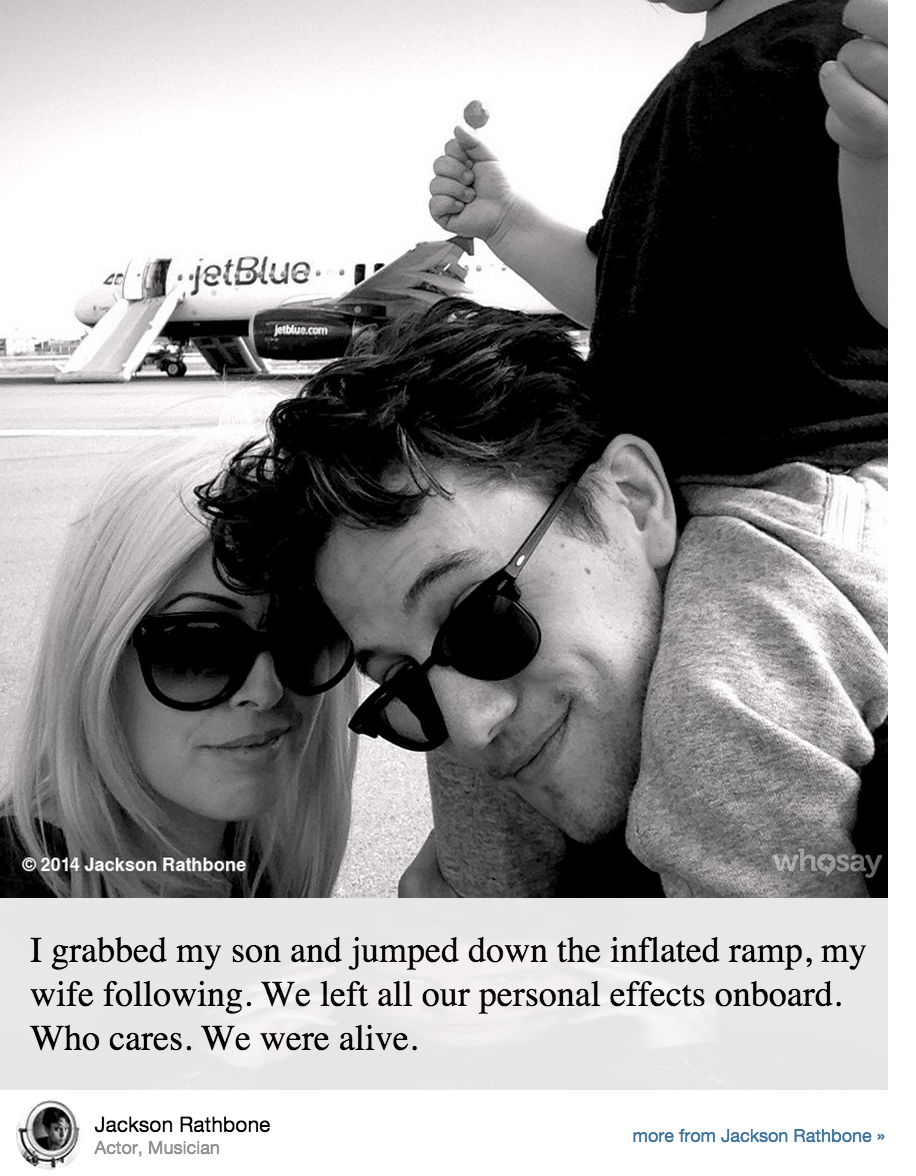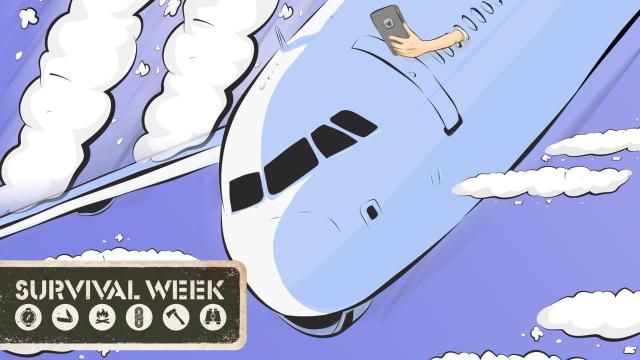When a United Airlines flight made an emergency landing this summer due to medical situations on board, as the oxygen masks fell down, some passengers’ phone cameras went up. But psychologists say the instinct to snap a selfie in a near-death experience isn’t all narcissism — it’s also about survival and self-preservation.
Emergency landing in Colorado on a @united flight. Not many brave lads when the masks drop from overhead. pic.twitter.com/Z4Um2uYhuD
— Sheamus (@WWESheamus) July 22, 2015
The ‘Survival Selfie’
Our friends over at Jezebel have written about this strange phenomenon, in which people take and post a selfie during or after an emergency. Such as in July, when United Flight 447 from Denver to LA made an emergency landing in Colorado because of several spontaneous medical situations as a result of oxygen problems on board. A few passengers whipped out smartphones as they affixed their masks.
Other oxygen mask selfies were taken in 2014 during emergency landings for a Singapore-bound flight and another headed for the Netherlands, when both experienced sudden losses in cabin pressure.
Meanwhile, last September, JetBlue Flight 1416 filled with smoke after an engine malfunctioned, forcing an emergency landing and prompted actor Jackson Rathbone to document the trauma in a series of photos and selfies.
Also last year, a US Airways Flight 1702 in Philadelphia aborted takeoff after the plane skidded into the runway nose-down and started smoking, but a Twitter user posted two selfies that went viral, after she safely evacuated and was a way’s away from the plane.
Finally, in the most stunning and saddest example, one man actually survived a small plane crash and took a selfie floating on a life raft in the Pacific Ocean near Hawaii, even filming some of the incident on his GoPro. Tragically, one person passed away in the incident.
It’s easy to roll your eyes at society, scoffing:”Taking a selfie is the last thing I’d be doing,” or “Wow, so it’s come to this.” But while danger isn’t new, smartphones and selfies are relatively so, and that’s sparked a new type of behaviour among some people faced with crises. We asked a couple psychologists why folks do this.
Some of it is narcissism, yes
“In general, the compulsion to take a picture of yourself during an emergency is unlikely to help your situation. It is possible that documenting other details in an emergency would be useful — odd noises, the visage of an attacker — but turning the camera on yourself is suggesting that you are the only (or the most important) detail in this situation,” says Jesse Fox, an associate professor in the School of Communication at The Ohio State University.
Back in January, Fox led a study about selfie psychology that was published in the journal Personality and Individual Differences. In it, it was revealed that men who took more selfies are more likely to suffer from problems like narcissism and psychopathy. But in the case of survival selfies? Fox says that while there could definitely be some posterity or journalistic motivation behind them, the practice might also involve some innate level of self-involvement.
“Making this documentation about the self — rather than the situation — indicates that a certain level of narcissism is still at play,” she explains. “People may be thinking ahead that their photos may be widely shared, and thus want to embed themselves as part of the action. Alternatively, they may be trying to prove that they were actually there.”
If the picture’s taken after the emergency, not during, the motives might be different. “Perhaps you want to offer friends and family evidence that you’re ok — or not,” she says. “Or, [you might want to] preemptively address questions regarding the trauma you just experienced.”

Image via WhoSay
It’s that need to document yourself in the face of death (or what you perceive to be the face of death) that taps into a psychological theory that might suggest survival selfies tap into a human need to self-preserve.
Selfies can be a legit coping mechanism
On a subconscious level, the instinct to snap a so-called survival selfies goes beyond simply jonesing for likes or shares or retweets. “I don’t think this is simple narcissism,” says Susan Krauss Whitbourne, professor of psychological and brain sciences at the University of Massachusetts, Amherst. “I think it’s related to this idea that when your mortality salience is heightened, you seek to preserve and protect your identity.”
What is “mortality salience,” you say? Whitbourne explains that it’s rooted in something called Terror Management Theory. It’s a school of thought that suggests fear of death is major driver behind human behaviour.
“Basically, TMT proposes that when we’re faced the prospect of our own mortality — mortality salience — we act in ways to try to preserve our sense of self or identity,” Whitbourne says.
That’s why snapping selfies could be considered a coping mechanism for humans facing a terrifying scenario. In some cases, people could even be posting selfies to give loved ones something to remember them by if worst comes to worst. Meanwhile, according to TMT, humans have a basic, survivalist compulsion to protect their self-identities in a life-or-death scenario. And what’s interesting is that, before selfies, humans didn’t really have the tools to act on their subconscious TMT compulsions in a dire event.
“No one is going to take a selfie while they are being robbed or attacked by a wild animal,” Fox says. (Apparently taking one moments before a wild animal attack is a different story, however.)
Smartphones have changed how we respond to danger
At the end of the day, the reasons people choose to self-document the things they do — especially if they just survived a brush with death — can be varied and nuanced and complex. For example, some folks might not even think they’re in any real danger, despite emergency procedures, and want to take a fun little selfie. Others might be seeking something familiar and banal that they can control in an obviously completely unusual and uncontrollable situation.
But generally, social media puts us in feedback loops that prompt selfies, in any circumstances. And if you’re taking a picture of yourself in a scary situation that elicits concern or interest from others on a wide scale, the need to take a selfie gets exacerbated.
“As long as people keep ‘liking’ those photos, sharing them, or making positive comments, selfies will continue,” Fox says. “If everyone cut off the social rewards for posting selfies and just ignored those posts entirely, they’d die off pretty quickly.”
Coming face-to-face with your mortality adds a new dynamic, though. If you’re the one in the trauma, the ‘survival selfie’ can be just that: proof of your survival. It’s proof that you went through some gnarly shit and came out on the other side ok. In the moment or in the immediate aftermath, it might be a raw human emotion — but perhaps days later, “the photos make an impressive addition to their social media feeds,” Whitbourne says.
“As the saying goes,” Fox says, “pics or it didn’t happen.”
Illustration by Sam Woolley
